$0.00
No products in the cart.
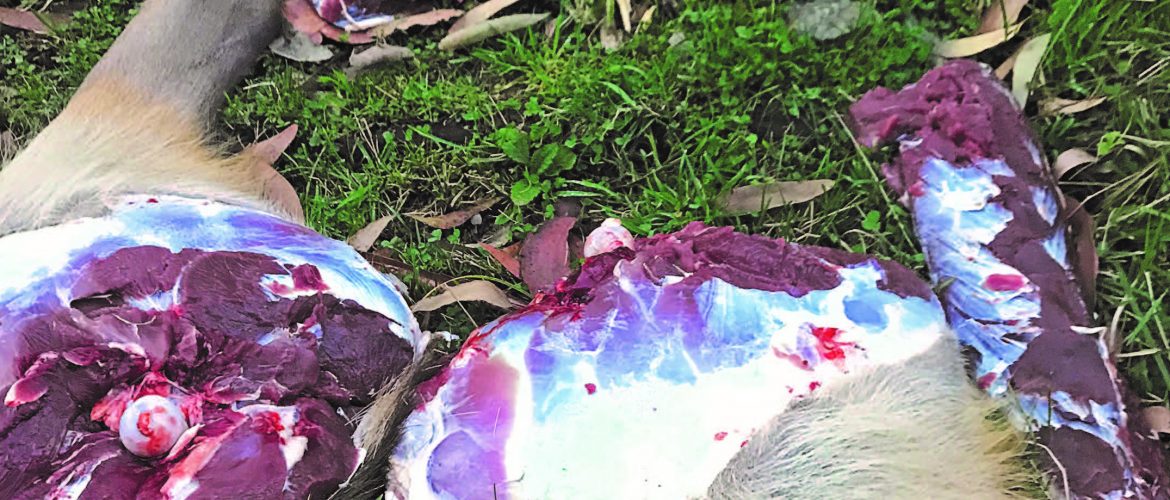
Imagine yourself stalking up a gully, wind is favorable, it’s an hour before dark, slightly overcast and deer are on their feet moving around filling their bellies before the impending storm. You approach a little bench and in between the trees notice a shape and color that just seems out of place. You bring your binoculars up to get a better view and an out of place stick is moving back and forth. You soon realize it’s the tip of a big heavy antlered stag that is coming into view. He walks into the middle of a clearing head down feeding, nice and relaxed. Heavy pearled antlers and long tines confirm he is a deer that takes an immense amount of work to locate and get a shot at. You don’t want to mess this up. A large tree offering low limbs for a steady rest is a few precious metres away. It’s time to scan the ground before you, take a couple slow steps towards that handy tree and ease into position. Suddenly the breeze swirls and swings around ever so gently, the clock is ticking, you have seconds to make it happen, there is no time to waste, your scent will soon get to him, you take the remaining steps to the tree, find a rest and look for him in the crosshairs.
By now the breeze has reached the stag and his head goes up, he lifts his nose trying to confirm what he thinks is near. You hold your ground desperately trying to pick a gap to thread a bullet through but he is covered in the branches of a tree halfway between you and him, your options are fading quickly. It’s decision time and you have to figure out whether to send one into the slither of chest you can now see, but that’s no good, the angle is to sharp, what about the base of the neck, risky shot and a stick covers most of it, not a good target either, easy to mess that up, his hind quarters are in view but you are unsure if the bullet will get through and you don’t like that option. Suddenly he tilts his head back sharply and gives a loud honk, it catches you by surprise, he wheels and bounds across the clearing and through the light scrub you see an opportunity up ahead. You find him in the scope and push those crosshairs past his galloping body, and in pure desperation let one rip. Your bullet centres a 12 inch snowgum and bark flies off exposing a gaping hole leaving nothing but bright orange timber underneath to remind you of a wayward shot. The stag is gone, the forest is silent and you are left there with an empty case at your feet, the smell of burnt gunpowder and a memory that will never disappear. It’s sambar hunting and a scenario that will often be repeated many times over each year in sambar country.
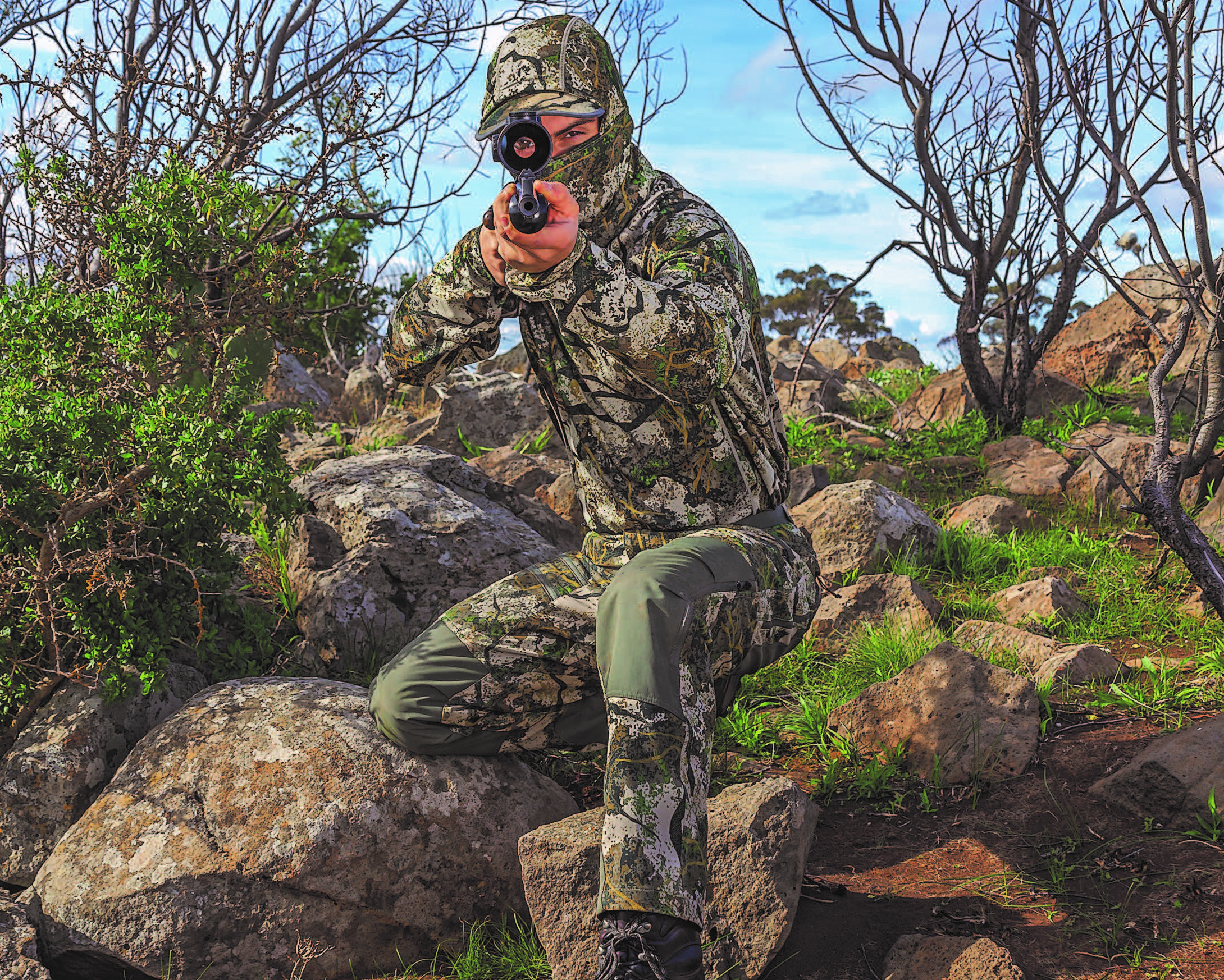
If we hunt often, and spend enough time in the field, these lost opportunities are bound to happen sooner or later and perhaps if we were all a bit better prepared there is every chance that we might swing the odds a little in our favor on these 50/50 opportunities and know what to do when its crunch time and a deer is onto you. Its true that sambar experiences like this will make us and shape us as hunters driving the passion deeper and fueling the fire, but as I look back at nearly 25 years of very regular sambar hunting I realize perhaps I could have been more organized in my younger years and better educated on having that knowledge and wisdom to get it done when its crunch time.
I remember walking back to camp with the head hung low thinking about the big one that got away a number of times and over the years there has been some beauties that I never harvested that I should have and the majority of these have been a result of poor shot selection or poor shooting in the field. The old saying of when there is lead in the air there is hope might be appropriate for waterfowl, but not so all of the time for our sambar.
On each of these occasions I remember thinking how could I have done things differently, maybe I should have taken the first opportunity that was presented and worked with what was offering up. There are so many scenarios playing through my mind from each missed up opportunity and the bottom line is I wasn’t prepared for all the situations I might have found myself in and more importantly I certainly didn’t have enough time behind the trigger of my deer rifle. Shooting off less then a box of ammo per year out of the Remington 7mm Magnum certainly didn’t do me any favors when I was in the field hunting sambar. I probably fluffed more deer by jerking the trigger and rushing situations then I care to remember and they are always hard lessons to learn as you think about the kilometers driven and the days invested each year on the hill.
This three part article will offer personal advice and first hand experience gained over countless days each year in the field hunting sambar in all situations. So much time and effort expended in the field hinges on those final few seconds of taking a shot that the pressure can be huge and if you keep ticking the right boxes in the lead up to squeezing that trigger hopefully you will find yourself walking up to dead deer a lot more often then cussing your misfortune.
Get down to the range:
Lets start with the basics and where every sambar hunter should begin and certainly where I as a younger hunter should have been practicing a lot more. Down at the range shooting and becoming familiar with your firearm is really important to the success of any future hunt. It’s so common to hear about new hunters who buy a couple boxes of ammunition, fire a few shots out of the new weapon to get it roughly on target and then think they are ready to go bush, climb a couple hills and knock over a few stags. This couldn’t be further from the truth and is right where trouble begins. I’ve talked to countless hunters who don’t have a lot of deer under their belts or experience in the hills that reminisce about the deer that got away simply because they missed it and did not shoot accurately or realize the importance of a good rest in the field. I used to think time at the range practicing on paper, was wasted, it was better spent in the hills learning about deer and hunting them, but it is an important part of your schedule to make time to get to the range or practice at targets in the field.
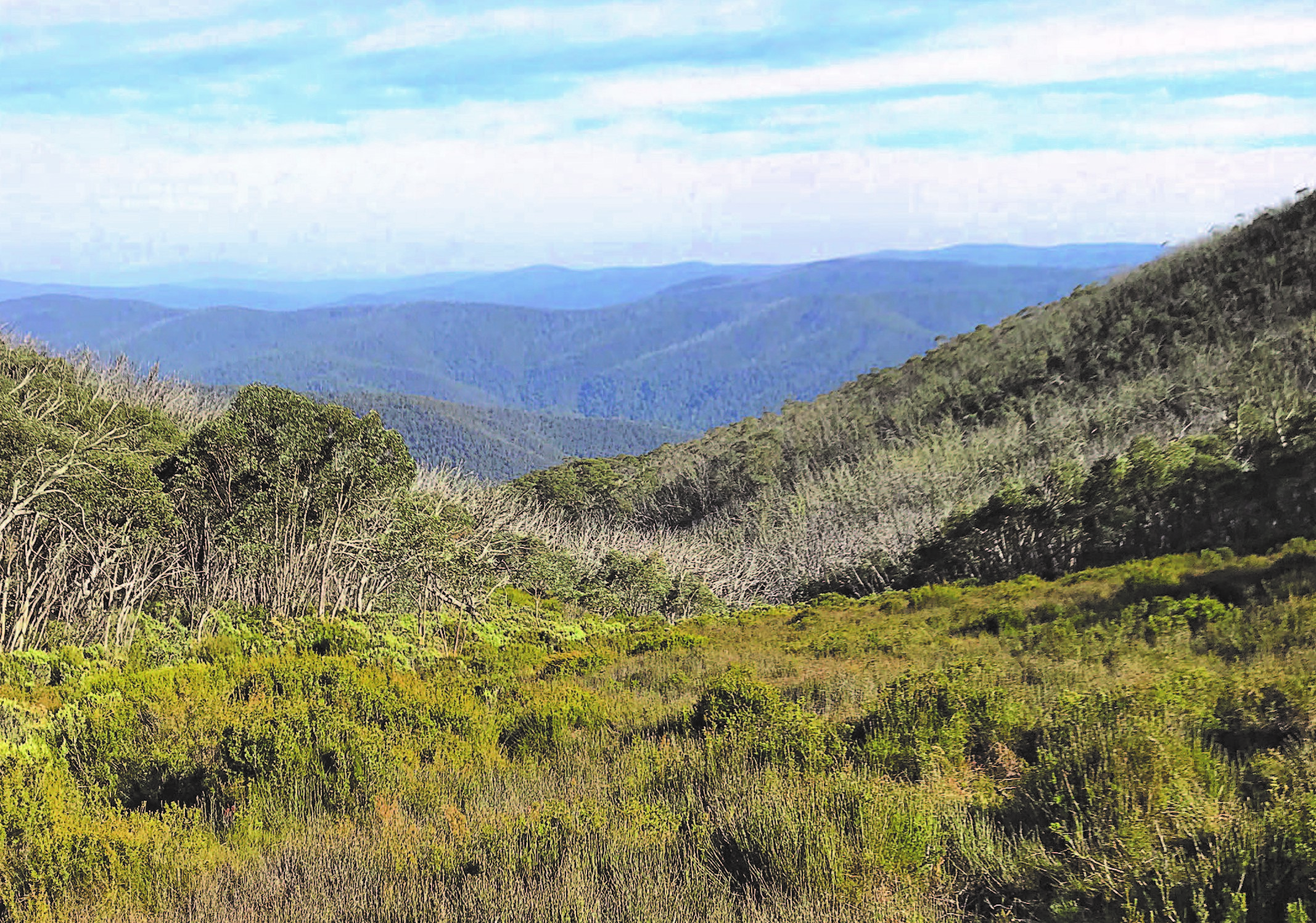
To start with I always recommend hunters ensure their rifle has the factory trigger adjusted to a short light pull at a safe setting they are comfortable with and that matches their experience level. Two to three pounds is acceptable if there is no creep and some hunters will often like their triggers a little lighter, but it depends on the rifle and the application. The triggers on many factory rifles are deliberately set on the heavy side for safety reasons and if you are new to the sport there is nothing wrong with getting started at these levels, but just be aware a lighter trigger definitely helps with consistent accuracy.
If you are new to the sport and get familiar with your rifle, you will realize it is hard to be accurate with any hunting rifle that has a heavy trigger and it often leads to people punching the trigger or holding tightly onto the pistol grip and tensioning prior to a shot in an attempt to reduce the effort required for it go off. This will clearly lead to inconsistent results and bad form in the field and at the range.
Best option if you want a better trigger is take your rifle to a gunsmith to have it lightened or replaced with an after market model. If you are experienced and competent with triggers you can have a go yourself, however it is not an area we recommend knew hunters work on their rifles for obvious safety reasons.
Whether you get a gunsmith to adjust a trigger or you do it yourself, always perform a few tests to ensure the rifle is functional and safe. At all times remember safety is absolute paramount for yourself and others so seek out professionals and pay for a service if you are in any way unsure with how to safely complete work on any part of your rifle.
Something I try to do is have all my hunting rifles with similar trigger pull weights. I do that so I can pick up any centrefire rifle in the safe, head out into the field and know its got a trigger pull that I am familiar with and used to. Familiarity is key to consistent accuracy in the field and at the range and if you keep everything uniform with other firearms in the safe it often leads to improved results.
When at the range don’t just send bullets down to the target and burn powder. Think about your hold on the rifle, your grip tension on the stock and the pressure you are placing anywhere on the rifle. Always aim for consistency and repetition for best results and actually approach each shot with the same thought processes so that when you are in the field everything is automatic. Try to shoot on both calm days (especially to sight in your rifle) and in windy weather to get an understanding of how any breezes affect flight path of your projectile. Many people will actually be amazed at how wind can really push those bullets around and remember the greater the distance the more affected your bullet will be from any breeze. Other factors that come into play regarding wind drift are bullet speed, bullet weight and ballistic co-efficiency of your projectile.
Make sure the reticle is in focus for your eyes and the parallax adjusted (if your scope has this feature), and always go through the same process of breathing and exhaling and taking the shot at the same stage of your breath cycle. At the start you might think you are over complicating things but as you shoot more you will notice everything should go on autopilot simply with repetition behind the trigger. For best results with grouping don’t move around too much between shots, don’t shoot with different holds on your rifle, simply reload and shoot again, provided you are comfortable behind the trigger. Use the same pressure process on the trigger and same techniques and you will be amazed at what accuracy most rifles are capable of.
Look at your groups, are they satisfactory and is your rifle accurate enough to take hunting. Even though sambar are large animals you still need a gun that is shooting hunting projectiles at least 1.5 inches or better in group size from a bench rest at 100 metres. Always follow through with each shot, by that I mean when you squeeze that trigger keep looking through the rifle scope, don’t lift your head off the cheek weld or stock to look above the scope, this will certainly create bad habits and poor form and is something you see so often down at the range and on hunting DVD’s and YouTube clips.
I like my rifles 1.5-2 inches high at 100 metres and this generally gives a 200 metre zero, caliber dependent, and then I know from ten metres out to 240-270 metres I will be within 3 inches (hi or low) of my point of aim. Once you have your rifle sighted in printing bullets on the target where you want them to land at 100 metres check it again with a bipod attached and see if the point of impact changes from the seated bench position you previously used. Some rifles don’t like different pressures along the forend of a stock and this can alter where those bullets are landing.
If you can also try a prone position do check the rifle again both off a rest and a bipod and hopefully all groups should be in the same position on the target. If they are you will have confidence in the field with most situations you will encounter when you need to get a rest.
Projectile selection can often be critical with any rifles accuracy so be aware that all projectiles are made with different shapes, materials and designs. Find the right combination in a good quality hunting bullet and use it.
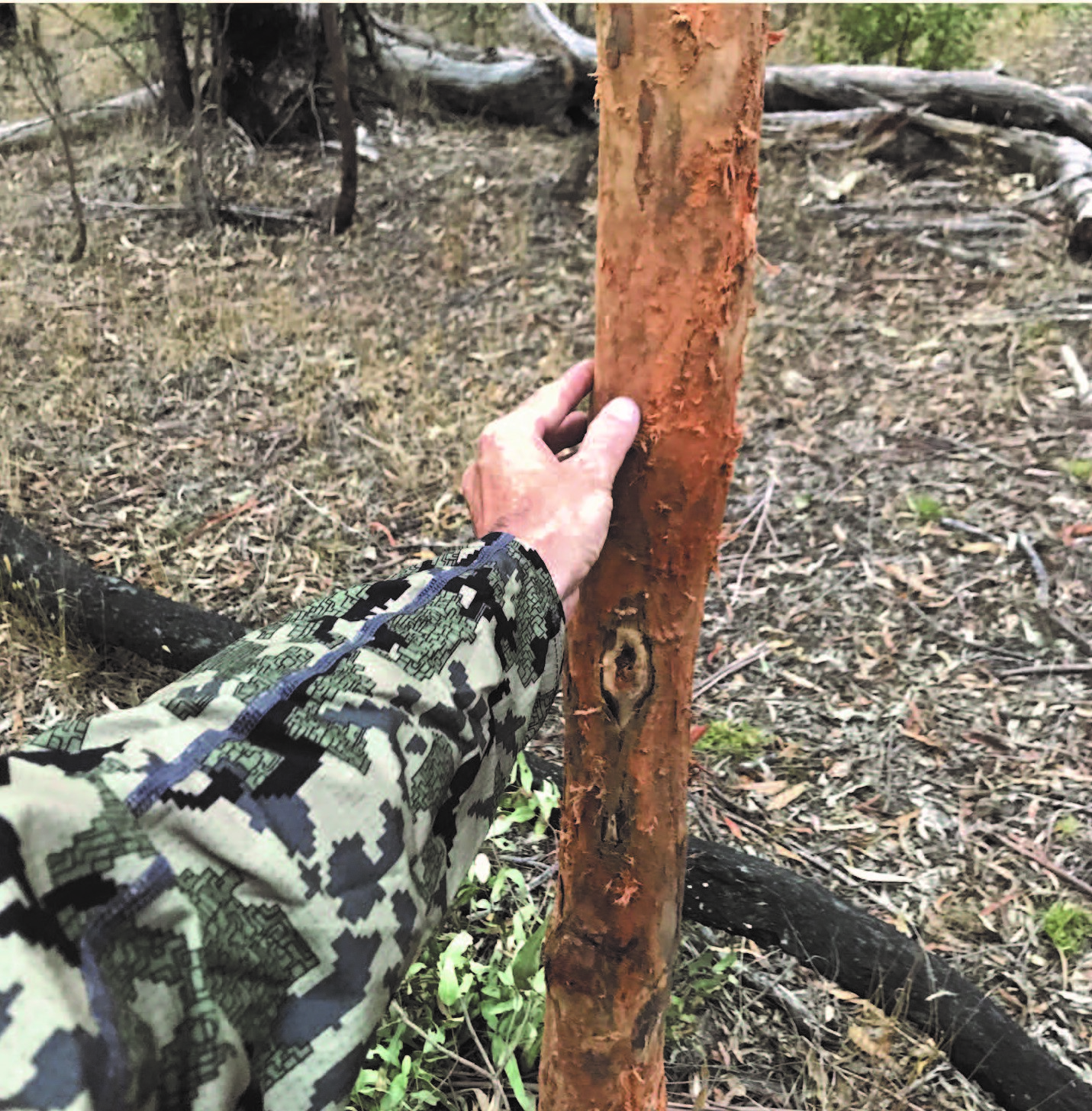
Once you are happy with your rifle grouping and initial sighting in take the time to shoot at targets from 25 metres out to three, four or five hundred metres and get a feel for how accurate you are at these ranges. Another important aspect of shooting out wider is you can gain a better understanding of your rifles trajectory and how the bullet path falls as speeds slow down.
Many hunters use scopes with elevation turrets now and make sure you always shoot the rifle out wide to check your calibrated bullet drop against the internal adjustments of the scope. Either have little charts printed up and stuck to the side of your stock or on the scopes objective lens and keep a few in places you can access. The backpack, binocular harness and pocket of your jacket are all great locations.
If you run a ballistic program on your device to allow for accurate adjustments of the turret make sure you are practicing at different ranges to iron out any kinks in your form and to ensure everything is calibrated to the data in your device. Shooting at steel targets will give you an idea of how far you can accurately shoot to be consistently ethical 100% of the time in the field. And remember in a field situation there are many more variables to consider then down at the bench with all the time in the world and a target that isn’t feeding in and out of view.
If you don’t have turrets but need to get an idea of how far your bullet drops still shoot the rifle out wide and write down the bullet fall on a drop chart to give you an idea of what any perceived holdover will be if an animal is out further then your maximum point blank range. Remember we don’t encourage long range hunting without a lot of time in the field and at the range, but it is better we educate hunters on the steps required to shoot accurately at longer then normal distances to increase their confidence and make them understand what their limits are in hunting situations.
Practice in all conditions to see the effect variables have on your bullets flight path. Windy days, rainy weather, hot days, angles with the shooting position and flight path of the bullet all affect how the bullet flies so learn your capabilities and improve on what you need to get better at. Angles are very important to practice as this simulates field shooting and many people will be surprised how shooting uphill/downhill effects the flight path and impact points of your bullet.
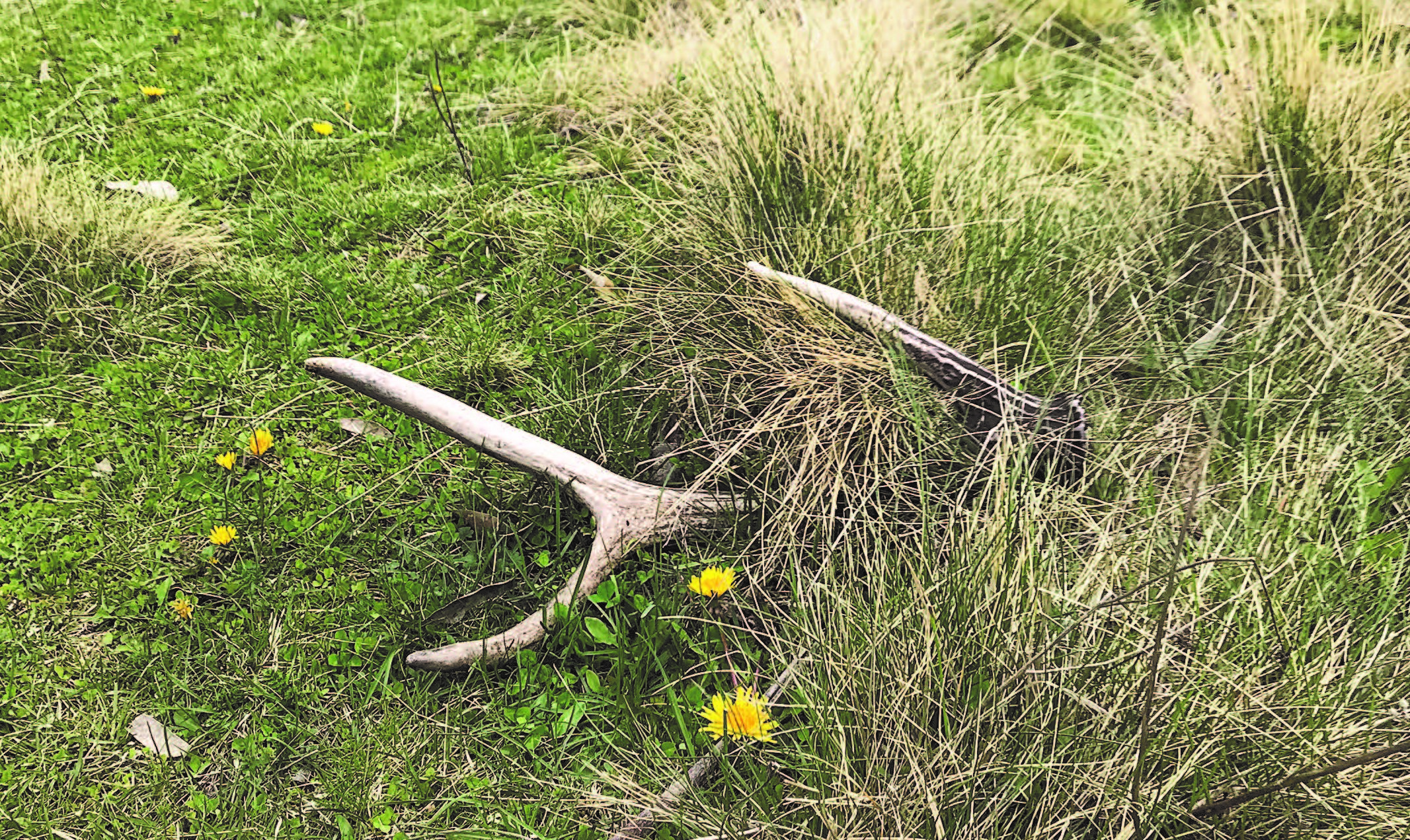
Shooting from different positions is also critical. You might be deadly of a bench rest or bipod with sandbags at 200 metres, but try shooting a few groups offhand at this range, from a kneeling position or sitting down with your backpack as a support. Its not until you actually simulate filed conditions that you begin to understand what ranges you will be efficient at in the bush. The groups you get off a bench at different ranges can be at least doubled or tripled in size in realistic hunting situations. So if you are shooting 4” groups off the bench at a certain distance that will mean at least 8” groups in the field and you wouldn’t want to be taking any shots further then this distance due to the heart and lung kill zone size of deer.
Never take shots at animals beyond your capabilities and always understand that being an ethical hunter is what we all should strive for each every time we head into the field. It’s not about numbers, scores, distances, or bragging rights, it’s about knowing your limits and sticking to them. Lastly the advantage of shooting at extended distances with your rifle down at the range will actually give you a lot of confidence in your weapon and will make those closer shots seem a lot more doable due to the fact you have been practicing out further and become a lot more competent with your weapon.
Buck fever and flinching:
Lets be honest, there probably isn’t a hunter alive who hasn’t had their heart racing when an opportunity presents with a sambar stag in front of them. So much time and effort can go into each encounter that the build up can be incredible and at the moment of truth it is often very hard to control your emotions and eagerness. Tales have been told long into the night about the big ones that have gotten away that should have been harvested and bullets flying off course, triggers slapped and wobbly crosshairs that were impossible to hold still. The only cure to this is get into the right mindset each and every time you get behind the trigger and practice in the field and at the range as often as possible. Tell yourself to take a few deep breaths if its helps prior to a shot, remind yourself to pick a spot on the animal and concentrate on that location holding the crosshairs there, make sure you have a good rest and always squeeze that trigger with good follow through looking down your scope after the shot rather then jerking that head up to see where the bullet went.
If you find you do rush shots where you have time, get into the habit of reminding yourself to squeeze the trigger as you are getting a sight picture and if it means practicing with your deer rifle on smaller game species and spending time down at the range to make you a better shot both under pressure and in the field on deer then do it.
Another reason hunters can develop poor shooting technique is they are shooting a firearm with a caliber that is too large for them to handle with confidence and recoil is causing a flinch or pulling of the trigger. Regarding excess recoil either get a muzzle break fitted to the barrel by a gunsmith, lower your bullet weight and powder charge if necessary or change calibers. A good after market recoil pad can often help and there are many out there that are simple to fit to the end of your stock.
Always use firearms that fit you well, some of the rifle manufacturers have a tendency to produce rifles a little short in pull for the taller hunters with longer arms and while spacers and recoil pads do help with length of pull, if you are new to hunting, pay some attention to the fit of a rifle along with other factors like cheek pieces on the stock to ensure your choices are made correctly the first time.
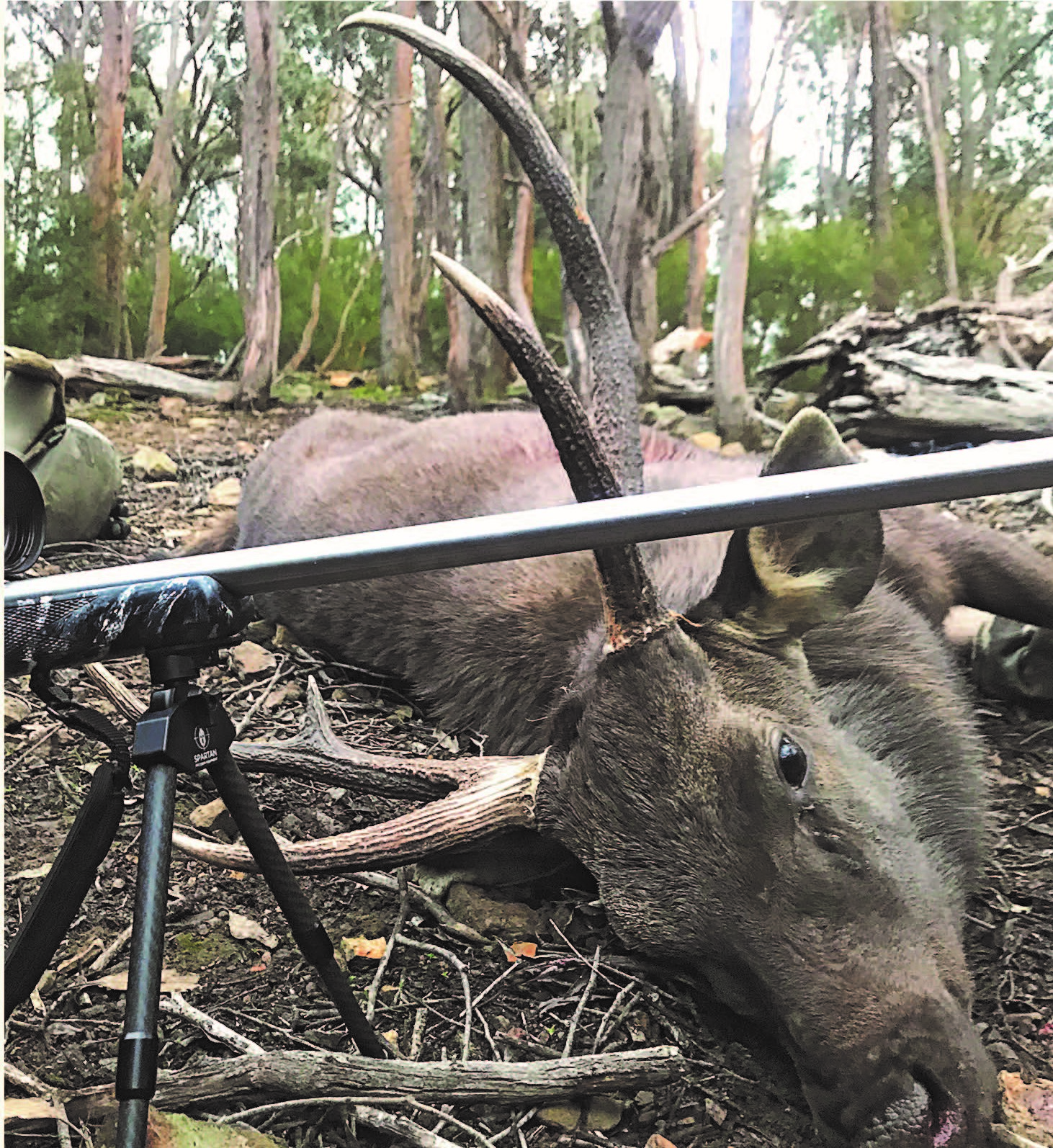
In summer, grab the .22 or centrefire, call foxes in and shoot bunnies as much as you can, its surprising how helpful shooting smaller calibers can be towards your form and technique with deer hunting rifles.
Following up after the shot:
Sambar being large animals, heavily boned, and muscular are notorious for absorbing poorly placed shots. They are resilient animals with a will to live so make sure you follow up after each and every shot. Sometimes you hear the tell tale thump of a projectile hitting flesh or bone floating back to you after the report of the rifle. Other times you will see the deer hunch up, leap into the air or stagger a little before moving off.
If the deer is making noise travelling through the bush get an indication of where it is going so you can relocate the spot easier, keep still and pinpoint the last known location you heard it move through and always listen for that tell tale crash of a animal falling over then silence. It normally indicates a deer is harvested. Not too often do sambar fall over on the spot, so its critical to always look for a deer after you shoot at it and always be aware that other animals moving away might confuse you with what direction your deer went.
I normally go to the location where the animal was standing when I fired and along the way look to make sure I didn’t put a bullet hole in a tree or limb. At the immediate area where the deer was I check for hair, spots of blood, scuff marks in the ground where the day may have leapt and try to get an indication of which direction he is travelling in. Is he following a well used game trail or is he crashing madly through the bush. Always remember that no sign of blood doesn’t mean you missed the animal, the skin is thick and the hair is coarse, and it can easily move over a bullet hole restricting blood or the blood can slowly drop onto the hair and restrict flow onto the ground. Typically lung and heart shots leave good blood trails if the bullets have excited and there are two holes for the blood to leave the body.
Never just assume wounded sambar head downhill, they often climb or contour when carrying a bullet wound and never give up on marks if they start climbing, always assume that bullet connected and follow the marks for a good distance before giving up. Often if you stay on them for 300 metres, give or take, you will have an idea of any blood and any signs of being hit. Most lung or heart shot deer will die within 150-200 metres of being hit so if you extend that distance a little with your search you are giving yourself a good opportunity of finding the animal if it was fatally hit. Of course if you find blood on the ground, on bushes, leaves, rocks or grass then definitely do your best to stay on the marks as long as you physically can or until you recover the deer. Staying on marks even if the shot does turn out a miss can have its positives. You can learn about the resident deer escape routes and how they utilize cover, terrain and habitat to their advantage. And you can sometimes even get a follow up shot if the deer settles down and hasn’t smelt you. Just because you have fired a gun doesn’t mean the deer will be in the next postcode as soon as he can. It’s a loud bang to the deer, it scares them yes, but they also hear lightening, rocks falling off cliffs and trees regularly falling down so keep that in mind.
If you know the shot was a fatal one and the deer is staggering, never stand there waiting for it to die or never think one shot is good enough. If it is safe to do so, always put in a follow up shot as soon as you can while the animal is in sight. Once you have hit a sambar your next shot might have to be taken on an angle or slowly moving animal so be light on your toes and get ready for a follow up shot as soon as you can.
If you shoot and the deer goes out of sight and you are confident of a hit there are two schools of thought as to what to do. Some people say give the animal time to die and don’t push things incase you bump it and other say get up there as quick as you can to get another shot in if its needed.
My personal reasoning on this is to always get that follow up shot in there as quick as possible. My reasoning being is if the first shot is fatal and the deer has run out of sight it will soon be dead and whether you wait 1 minute or 30 minutes to get up there the result is the same, dead deer over the hill. If however the deer is not fatally wounded, and remember sambar are incredibly resilient towards carrying poorly placed bullets then you are far better off with getting up there as soon as possible and relocating the animal before it puts too much distance between where it was when you fired at and where it now is. Remember the further away it moves from the location it was hit the less likelihood you have of finding it without the assistance of dogs, good luck or good tracking skills. So waiting a period of time before moving up on a hit sambar can in my opinion simply give the poorly hit ones more opportunity to escape. Other species of game are more susceptible to shock and less then perfect shot placement but not our sambar, they simply have that will to live so long as they are breathing.
Animals that fall over and get back up and run away at a shot tend to not be as mortally wounded as animals that run off after a shot then fall over. Always make sure a deer is dead when you walk up to it, because sometimes a projectile near the spine or neck vertebrae can effectively knock the deer out for a short period of time but not kill it. If a sambar is still breathing and kicking when you walk up to it, humanely dispatch it with another round, bullets are cheap and deer are a great resource never to be treated with poor values.
Learn from the deer:
When a deer is successfully harvested the learning never stops. Take note of the color and type of blood on the ground in relation to your shot placement so you can understand blood trails more effectively in the future. Muscle blood is a lot different to blood being pumped through the internal organs so take a moment to familiarize with this important variance.
When breaking down the deer for consumption or skinning the deer for mounting, have a good look at the carcass and skeletal structure as the hide is removed. The bone placement of the major limbs is often different to what many assume and you will see how the neck vertebrae sits a lot lower then many realize in the thick muscles of the animal. Also that big gap created by angle of the humerus and scapula bones should be noted by both bow and rifle hunters.
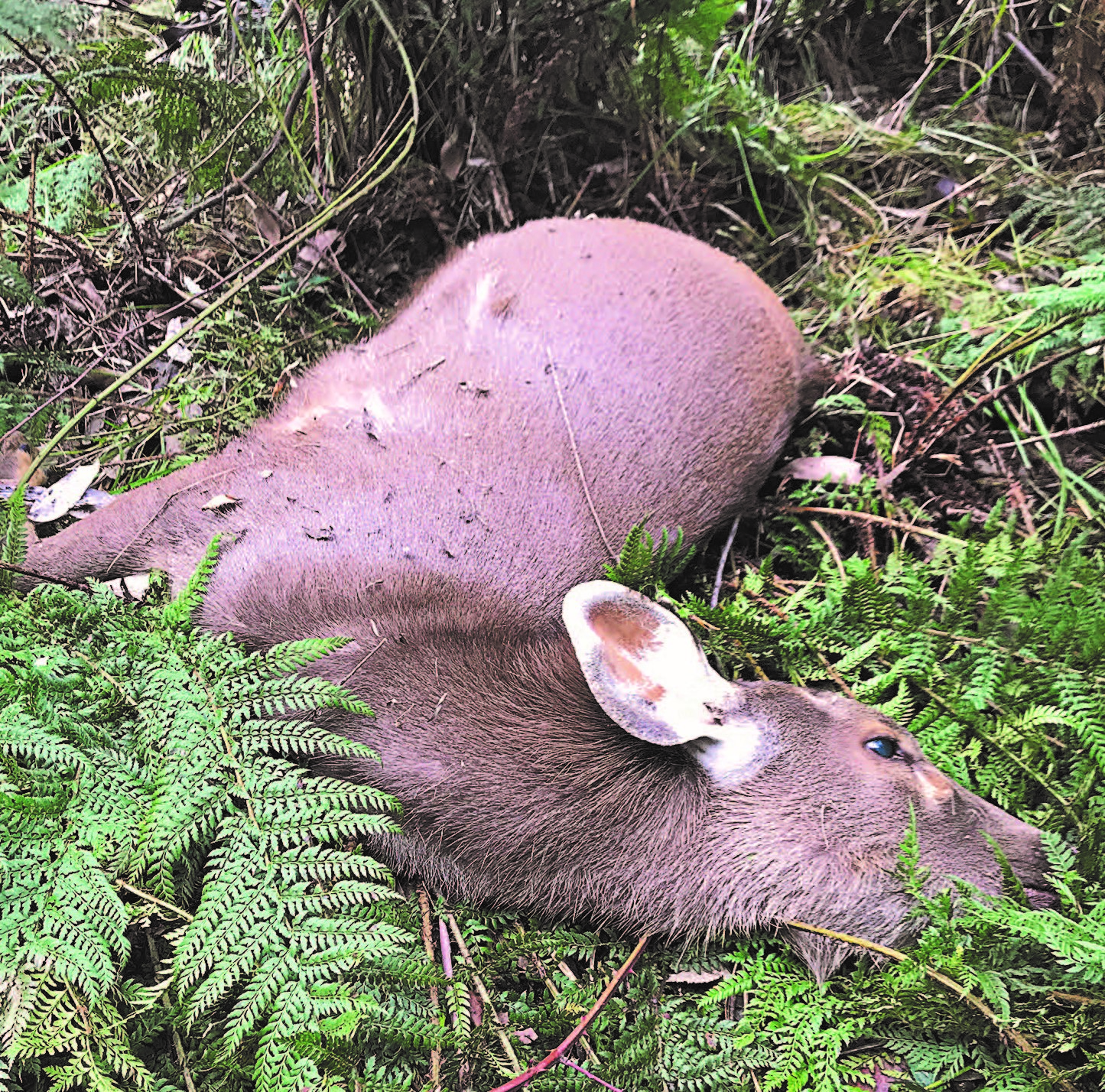
As the carcass is broken down and lying flat on its side take time to cut or saw through the ribs if you can and get a good look at where the important organs sit. The heart and lungs are critical for the survival of any animal and a lethal aiming point. See where the liver tucks into the organs and take note of how far forward the stomach contents sit. The stomach contents take up a considerable amount of space internally with any sambar so gain knowledge on this and obviously try to avoid it with any bullet placement. The spine along the back sits lower in the chest region then many also realize and the scapula bones often give a false indication of where this sits.
Gear Selection:
On the subject of rifles and gear, we always recommend to buy quality products the first time round if possible. Before outlaying your hard earned cash do your research and really fine tune the gear to your sambar hunting.
In regards to riflescopes reticles can vary immensely and you need to suit the reticle to the type of hunting you will be doing. There is no point having a reticle with a heap of hash marks and MOA lines if all you are doing is bush stalking and taking close range shots, it will just be too cluttered and obtrusive, especially trying to pick an aiming point on an animal that is moving. Don’t over complicate things, keep it simple and standard plex or 4A reticles are ideal, just make sure that those thinner sections of a reticle can be easily seen as some are manufactured quite thin and in bush situations with limbs, branches and twigs often in the way it can be hard to see when reticles are too fine. They might be good for a fox gun, but not a sambar stalking rifle.
Select the most versatile magnification range for your scope and choose optics that are of a good quality. A lot will come down to firstly locating deer and then being able to see it. Often sambar are encountered in low light conditions and optics are essential. Clothing that is warm, functional in the field, comfortable and quiet when moving through scrub is important. If you get cold or wet, often you will want to go home or get back to camp or the ute and this will lead to missed opportunities that might have been presented if you had of stayed in the field longer. Get a good warm fleece or woolen beanie, find some gloves to keep your hands warm and covered and soon you will find those cold days wont be so miserable and turning back towards camp early is not an option.
Its important to not have gear that will prohibit the safe and accurate shooting of rifles in the field. The more pockets you have on a jacket the more likelihood you will be to fill them with something and this could get in the way when you are bringing the rifle up in a hurry or they could make extra noise when your positioning for a shot. Keep everything streamlined and simple and use a backpack to store non essential items. In regards to backpacks, there is an endless supply of them out there and always new products hitting the market. Most have a purpose, however some features I always look for are them to be silent in the bush, low profile so when stalking and bending over you wont get caught up on scrub and overhanging branches and I like supportive but thin shoulder straps. I will take wider but slightly thinner shoulder straps that are more comfortable then thick narrow straps that feel obtrusive when you bring the rifle up and settle it into your shoulder for a shot whilst wearing the pack. It’s amazing how uncomfortable some packs straps feel when you try to shoot when wearing the pack, they might be great for hiking and backpacking in but you simply need every item to be functional. Often this is a situation sambar hunters will be faced with so give every purchase or gear upgrade some thought.
All this information might sound common knowledge to many hunters already successful in the field but we also realize there are plenty of new hunters getting into the wonderful pursuit of sambar and many are thirsty for knowledge.
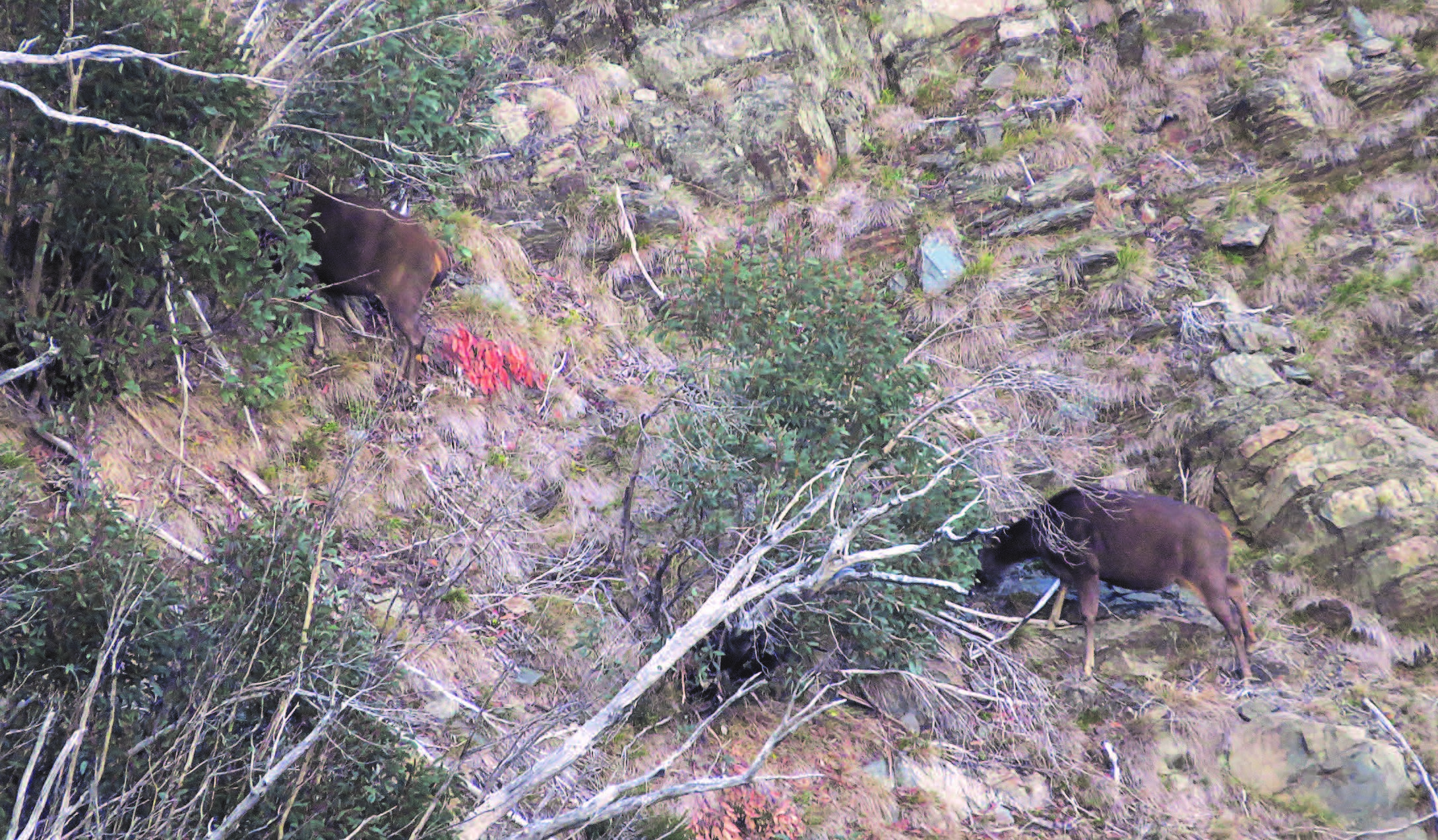
For the new hunters out there it can be a challenge to meet guys who hunt if you haven’t grown up in a hunting family or rural community. I’d suggest you find like minded people with an interest in deer and similar ethics and you will hopefully be able to create long lasting friendships. Joining hunting clubs is very important and a great place to learn about all aspects of hunting and deer and many will have regular club hunts and weekends away. These can be great opportunities for new hunters and time around a campfire discussing calibers, bullet selection and shot placement can be robust and enlightening with a group of hunters. All the clubs throughout Australia and Victoria have different approaches to hunting methods and generally members will affiliate with whom they feel most comfortable with.
Pass your hound hunting test and try hound hunting, it’s a fast way to learn about deer and there is always good times to be had in the field with hound hunters. Chat to guys on social media and get advice and build friendships and never be afraid to stop and have a conversation with another hunter you see in the bush, on a track or at a campfire. If you approach in a welcoming way and be respectful to them and the areas they are hunting often you can be asked to share a campfire in the future or exchange details to share information on track closures, deer movements and general hunting news. Having a good relationship with a few keen hunters is always beneficial for the long term enjoyment of the pursuit of sambar.
Always be safe in the field and around camp with your firearm, identify that target at all times and remember its better to hold off on the trigger then to let one fly if you are not 110% certain there is a deer in front of you.